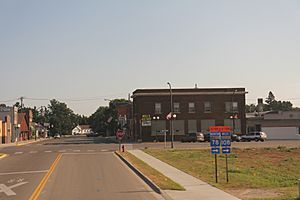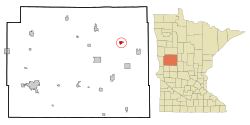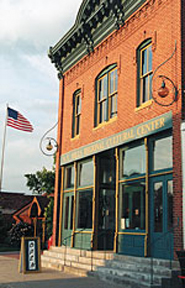New York Mills, Minnesota facts for kids
Quick facts for kids
New York Mills
|
|
|---|---|

Downtown New York Mills
|
|
| Motto(s):
"Small Town, Big Life."
|
|

Location of New York Mills, Minnesota
|
|
| Country | United States |
| State | Minnesota |
| County | Otter Tail |
| Founded | 1884 |
| Area | |
| • Total | 1.46 sq mi (3.77 km2) |
| • Land | 1.45 sq mi (3.76 km2) |
| • Water | 0.00 sq mi (0.01 km2) |
| Elevation | 1,417 ft (432 m) |
| Population
(2020)
|
|
| • Total | 1,294 |
| • Estimate
(2023)
|
1,355 |
| • Density | 890.57/sq mi (343.87/km2) |
| Time zone | UTC-6 (Central) |
| • Summer (DST) | UTC-5 (CDT) |
| ZIP code |
56567
|
| Area code(s) | 218 |
| FIPS code | 27-46060 |
| GNIS feature ID | 2395221 |
New York Mills is a small city located in Otter Tail County, Minnesota, United States. It's a friendly place with a motto of "Small Town, Big Life." In 2020, about 1,294 people lived here.
Contents
History of New York Mills
New York Mills was officially planned out in 1883. Many of the first people to settle and build up the city were Finns, who came from Finland.
Geography and Climate
New York Mills covers an area of about 1.30 square miles (3.37 square kilometers), and all of it is land.
Understanding the Climate
The weather in New York Mills changes a lot throughout the year. Summers are generally warm, while winters are very cold.
| Climate data for New York Mills, Minnesota, 1991–2020 normals, extremes 2000–present | |||||||||||||
|---|---|---|---|---|---|---|---|---|---|---|---|---|---|
| Month | Jan | Feb | Mar | Apr | May | Jun | Jul | Aug | Sep | Oct | Nov | Dec | Year |
| Record high °F (°C) | 50 (10) |
54 (12) |
73 (23) |
91 (33) |
97 (36) |
97 (36) |
100 (38) |
97 (36) |
93 (34) |
88 (31) |
72 (22) |
50 (10) |
100 (38) |
| Mean maximum °F (°C) | 40.1 (4.5) |
41.3 (5.2) |
57.1 (13.9) |
72.5 (22.5) |
85.4 (29.7) |
86.3 (30.2) |
89.1 (31.7) |
87.5 (30.8) |
83.1 (28.4) |
75.0 (23.9) |
59.0 (15.0) |
42.1 (5.6) |
90.6 (32.6) |
| Mean daily maximum °F (°C) | 17.0 (−8.3) |
22.3 (−5.4) |
35.0 (1.7) |
50.5 (10.3) |
63.8 (17.7) |
74.1 (23.4) |
79.0 (26.1) |
76.3 (24.6) |
68.5 (20.3) |
52.2 (11.2) |
36.3 (2.4) |
22.8 (−5.1) |
49.8 (9.9) |
| Daily mean °F (°C) | 7.5 (−13.6) |
11.7 (−11.3) |
25.3 (−3.7) |
39.8 (4.3) |
53.0 (11.7) |
63.6 (17.6) |
68.5 (20.3) |
65.7 (18.7) |
57.5 (14.2) |
42.8 (6.0) |
27.9 (−2.3) |
14.6 (−9.7) |
39.8 (4.4) |
| Mean daily minimum °F (°C) | −1.9 (−18.8) |
1.1 (−17.2) |
15.5 (−9.2) |
29.1 (−1.6) |
42.2 (5.7) |
53.0 (11.7) |
58.0 (14.4) |
55.0 (12.8) |
46.6 (8.1) |
33.3 (0.7) |
19.5 (−6.9) |
6.5 (−14.2) |
29.8 (−1.2) |
| Mean minimum °F (°C) | −24.2 (−31.2) |
−22.1 (−30.1) |
−9.9 (−23.3) |
12.9 (−10.6) |
27.5 (−2.5) |
41.1 (5.1) |
47.5 (8.6) |
43.3 (6.3) |
32.0 (0.0) |
19.6 (−6.9) |
1.8 (−16.8) |
−16.5 (−26.9) |
−27.4 (−33.0) |
| Record low °F (°C) | −37 (−38) |
−33 (−36) |
−25 (−32) |
−3 (−19) |
21 (−6) |
32 (0) |
42 (6) |
36 (2) |
27 (−3) |
12 (−11) |
−8 (−22) |
−28 (−33) |
−37 (−38) |
| Average precipitation inches (mm) | 0.38 (9.7) |
0.63 (16) |
0.91 (23) |
2.02 (51) |
3.33 (85) |
4.48 (114) |
4.86 (123) |
3.15 (80) |
2.94 (75) |
2.53 (64) |
0.82 (21) |
0.83 (21) |
26.88 (682.7) |
| Average snowfall inches (cm) | 9.6 (24) |
8.0 (20) |
7.8 (20) |
3.3 (8.4) |
0.0 (0.0) |
0.0 (0.0) |
0.0 (0.0) |
0.0 (0.0) |
0.0 (0.0) |
1.2 (3.0) |
5.3 (13) |
10.4 (26) |
45.6 (114.4) |
| Average precipitation days (≥ 0.01 in) | 5.3 | 5.3 | 6.0 | 7.1 | 10.4 | 12.4 | 10.4 | 8.8 | 10.0 | 9.3 | 5.2 | 6.6 | 96.8 |
| Average snowy days (≥ 0.1 in) | 6.3 | 5.9 | 4.6 | 1.8 | 0.0 | 0.0 | 0.0 | 0.0 | 0.0 | 0.8 | 3.5 | 7.0 | 29.9 |
| Source 1: NOAA | |||||||||||||
| Source 2: National Weather Service (mean maxima/minima 2006–2020) | |||||||||||||
Getting Around New York Mills
U.S. Route 10 is the main road that runs through the city, making it easy to get around.
For longer trips, the Empire Builder train, run by Amtrak, passes through New York Mills. This train travels between Seattle/Portland and Chicago. However, it does not stop in New York Mills. If you want to catch the train, the closest stations are in Staples, about 31 miles (50 km) to the southeast, or Detroit Lakes, about 32 miles (51 km) to the northwest.
Population and People
The number of people living in New York Mills has changed over the years. Here's how the population has grown:
| Historical population | |||
|---|---|---|---|
| Census | Pop. | %± | |
| 1890 | 260 | — | |
| 1900 | 353 | 35.8% | |
| 1910 | 474 | 34.3% | |
| 1920 | 700 | 47.7% | |
| 1930 | 667 | −4.7% | |
| 1940 | 771 | 15.6% | |
| 1950 | 977 | 26.7% | |
| 1960 | 828 | −15.3% | |
| 1970 | 791 | −4.5% | |
| 1980 | 972 | 22.9% | |
| 1990 | 940 | −3.3% | |
| 2000 | 1,158 | 23.2% | |
| 2010 | 1,199 | 3.5% | |
| 2020 | 1,294 | 7.9% | |
| 2023 (est.) | 1,355 | 13.0% | |
| U.S. Decennial Census 2020 Census |
|||
A Look at the 2010 Population
In 2010, there were 1,199 people living in New York Mills. Most residents were White (94.8%). A small number of people identified as Native American (1.8%) or African American (0.3%). About 1.8% of the population was Hispanic or Latino.
The average age of people in the city was about 38.9 years old. About 23.9% of the residents were under 18, and 22.5% were 65 or older.
Arts and Local Economy
New York Mills was started in 1884 by immigrants from Finland. Today, the main jobs in the area are in farming (like growing crops, grains, and dairy), making fishing boats at the Lund Boat Company, and various service jobs. Tourism is also becoming more important because Otter Tail County has over 1,000 lakes, which attract visitors.
New York Mills Regional Cultural Center
To help the town grow and attract more people, New York Mills decided to create a special place for arts and culture. In 1991, the city invested money to turn an old building into the New York Mills Regional Cultural Center. This center opened in 1992 and is a non-profit organization that supports art. The community helped remodel the building with volunteer work.
The Cultural Center has helped the town stay strong economically. It brings in visitors, activities, and money, and has even gained national attention.
Programs at the Center
The Cultural Center offers many fun and educational programs:
- Artist-In-Residence Program: Artists come to live and work in the community.
- Education/Outreach programs: These programs teach people about different art forms.
- Gallery Exhibits: You can see amazing art from different artists.
- “Great American Think-Off” Annual Philosophical Debate: This is a yearly debate where people discuss big ideas.
- Literary and Theater Events: Enjoy readings, plays, and other performances.
- Music Concert Series: Listen to live music from various artists.
- Sculpture Park: See outdoor sculptures in a special park.
Artists Who Have Exhibited
Many talented artists have shown their work at the Cultural Center, including:
- Robin Barcus Slonina
- Charles Beck
- Betsy Bowen
- Duane & Bambi Goodwin
- Eric Johnson
- Kent Kapplinger
- Maxwell MacKenzie
- David Salmela
- Charvis Harrell
Famous People From New York Mills
Some notable people have connections to New York Mills:
- Peter Hayes: A guitarist and singer in an indie rock band.
- Janet Karvonen: A pioneer in girls' basketball.
- Dean Simpson: A businessman who also served in the Minnesota state government and as mayor.
See also
 In Spanish: New York Mills (Minnesota) para niños
In Spanish: New York Mills (Minnesota) para niños



